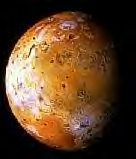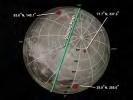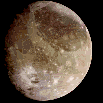| IO In contrast to most of the moons in the outer solar system Io and Europa may be somewhat similar in bulk composition to the terrestrial planets, primarily composed of molten silicate rock. Recent data from Galileo indicates that Io has a core of iron. This moons surface is radically different from any other body in the solar system with relatively few impact craters, probably indicating the surface to be very young. Instead of craters, which scientists believed Voyager 1 would find, the space craft found hundreds of volcanic calderas. striking images of some actual eruptions with plumes 300km high were sent back by both Voyager and Galileo. This may have been the most important discovery of the missions...it was the first real proof that the interiors of other 'terrestrial bodies are actually hot and active. The material erupting from Io's vents appears to be some form of sulphur of sulphur dioxide. The volcanic eruptions change rapidly. The volcanic eruptions change rapidly, in just four months between the Voyager missions some of them stopped and others started. The deposits surrounding the vents also changed visibility. Io has an amazing variety of terrains: calderas up to several km deep, lakes of molten sulphur, mountains, extensive flows hundreds of km long of some low viscosity fluid, and volcanic vents. Sulpher and its compounds take on a wide range of colours which are responsible for the moons variegated surface. Analysis of the Voyager images led scientists to believe that the lava flows on Io's surface were compounds of molten sulphur. However subsequent studies have indicated that they are too hot for liquid sulphur. One such idea proposes that the lavas are molten silicate rock. Furthermore some of the hottest spots on this moon can reach 2000K, yet the average for the planet as a whole is 130k, and so these hot spots are the principal mechanism by which Io loses its heat. The energy for all this activity probably derives from tidal interactions between Io, Europa, Ganymede and Jupiter. These three moons are locked into resonant orbits such that Io orbits twice for each orbit of Europa, which in turn orbits twice for each orbit of Ganymede. Though Io, like the earths moon always faces the same side towards its planet, the effects of Europa and Ganymede cause it to wobble a bit. This wobble stretches and bends Io by as much as 100 metres, and generates heat as a consequence. Io also cuts across Jupiter's magnetic field lines, generating an electric current. Though small compared to the tidal heating,, this current may carry more than one trillion watts. It also strips some material away from Io which forms a torus of intense radiation around Jupiter. Particles escaping from this torus are partially responsible for Jupiter's unusually large magnetosphere. Lastly it is important to point out that unlike the other Galilean satellites, Io has little or no water. This is probably because Jupiter was hot enough early in the evolution of the solar system to drive off the volatile elements in the vicinity of Io but not so hot to do so farther down.
GANYMEDE Prior to the Galileo encounters with this moon it was thought that both Ganymede and Calisto were composed of a rocky core surrounded by a large mantle of water ice with an ice surface. However initial indicators from Galileo suggested that Calisto had a uniform composition whilst Ganymede is differentiated into a three layer structure: a small molten iron or iron sulphur core surrounded by a rocky silicate mantle with an icy shell on top. Effectively Ganymede could be extremely similar to Io, with an additional outer layer of ice. Ganymede's surface is a roughly equal mix of two types of terrain, very old highly cratered dark regions, and somewhat younger lighter regions marked with an extensive array of grooves and ridges. There origin is clearly of a tectonic nature, but as yet the detail explaining this activity is unknown. Given this evidence this moon may actually be more similar to the earth than either Venus or Mars!!! Furthermore there may even be evidence of a very tenuous oxygen atmosphere on Ganymede, which is very similar to the one found on Europa. It has mountains, valley's and lava flows. Ganymede is the largest moon of Jupiter and is the largest in the solar system, and if it orbited the sun instead of Jupiter then it would be classed as a planet.
CALISTO Unlike Ganymede, Calisto seems to have little internal structure. However there are signs from Galileo that the interior materials have settled partially, with the percentage of rock increasing towards the centre. Calisto is therefore about 40% ice and 60% rock/iron. Its surface is covered entirely with craters and it is estimated that this cratered surface was the oldest of any body in the solar system, having undergone little change other than the occasional impact for 4 billion years. The largest craters are surrounded by a series of concentric rings which looks like huge cracks but which have been smoothed out by eons of slow movement of the ice. The largest of these is named Valhalla, and nearly 3000km in diameter, it is a dramatic example of a multi ring basin, the result of a massive impact. Like Ganymede, Calisto's ancient craters have collapsed, suggesting that some processes had been at work, even if it was just slumping. A further interesting feature is Gipul Catena, a long series of impact craters lined up in a straight line. This was probably caused by an object that was tidally disrupted as it passed close to Jupiter and then impacted on Calisto. Its atmosphere can be described as tenuous, composed of Carbon dioxide. Unlike Ganymede, with its complex terrain, there is little evidence of tectonic activity on Callisto. whilst Callisto is very similar in bulk properties to Ganymede, it apparently has a much simpler geological history. Indeed this moon may provide a good comparison with other more complex worlds as it may represent what other Galilean moons were like early in their history. |
![]() Copyright(C) 2007
- 2020. All rights reserved.
Copyright(C) 2007
- 2020. All rights reserved.





